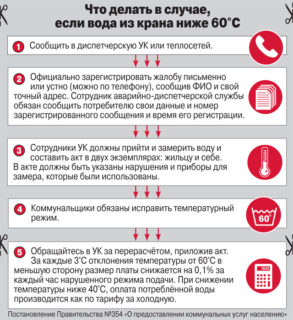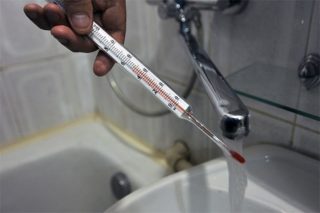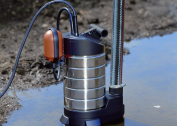One of the factors of a comfortable life in an apartment building is the constant supply of hot water. The fluid must comply with sanitary and construction requirements, including temperature indicators. If the standards are violated, consumers have the right to prosecute those who oversee the water supply of the building.
Hot water temperature standards
 The temperature of the heated water is set by SNiP N II – 34–76 and SanPiN 2.1.4.2496-09. As for heating, GOST R 51617–2000 determines the permissible values during the heating season. They differ for different rooms, for example, for a living room it is 18 degrees, for a bathroom - at least 25.
The temperature of the heated water is set by SNiP N II – 34–76 and SanPiN 2.1.4.2496-09. As for heating, GOST R 51617–2000 determines the permissible values during the heating season. They differ for different rooms, for example, for a living room it is 18 degrees, for a bathroom - at least 25.
The maximum temperature of the liquid that flows to the water intake point should not be more than 75 degrees, otherwise it can burn a person. In addition, excessively heated liquid damages the details of the water supply system, especially if they are made of polymeric materials.
Barely warm water is also not the norm. The calculation of the minimum temperature indicator is based on the type of water supply system. If it is open, the value is 70 degrees, closed - 60 degrees. The first criterion is higher, since networks have greater heat transfer during operation.
The temperature of hot water in the water supply system is less than the permissible standards can lead to the development of pathogenic microorganisms in it - pathogens of infections.
Tolerances
Regulatory requirements provide for a slight temperature fluctuation:
- from 12 nights to 5 in the morning, a decrease of five degrees is possible;
- in the afternoon - only three degrees.
In addition, there is a temperature schedule that provides for the heating of water at the outlet of the boiler house or CHP according to the season. During the winter cold, this value increases to compensate for heat loss in heating devices and create comfort for living - not lower than 18 degrees.
If the hot water supply in a multi-storey building does not meet regulatory requirements, it is necessary to send a claim to the management company serving the house.
DHW temperature measurements
In order to induce utility workers to take measures, before filing a claim, it is necessary to measure the water temperature in the in-house hot water supply system.
- Open the tap and drain for three minutes.
- Fill any tank with flowing fluid. Do not block the flow, let the water flow over the edges.
- Place an ordinary household thermometer in the tank.
- Record the maximum performance.
To check, choose evening time or a cloudy day, since when the air is heated by the sun, the water in the DHW system will also be warmer.
If the temperature values do not meet the standards, you must contact the housing department. The dispatcher will accept the application and establish the reasons - it is likely that deviations have arisen due to malfunctions in the main pipeline or during scheduled work. If there are no temporary problems, write a complaint to the Criminal Code. They should respond to it no later than two hours after the appeal.
The specialist will conduct a repeated temperature measurement and draw up an act, which, if there is a discrepancy, will become the basis for recalculation for the service not rendered.
Usually, UK employees try to disown water consumers and send them to a heat supply organization. But in most cases, the management company should decide the issue.After all, the organization supplying heat resources is only responsible for transporting the coolant to the distribution node of the house network.
If the Criminal Code does not take any measures, contact the Housing Inspectorate or the prosecutor. To confirm complaints about the quality of public services, you will need to organize an independent examination at your own expense, and then submit a claim to the managing organization to reimburse its cost.
According to the Federal Law No. 195, persons who have caused violations are fined: in the amount of 500 to 1000 rubles for officials, and from 5 to 10 thousand rubles for the company itself.
Possible reasons for non-compliance
Temperature readings may depend on whether the system is dead end or circulating. In networks of the first type, in the absence of water intake, the liquid in the pipes will inevitably cool. Its cooling rate can be reduced by heat insulation of the filling.
Unforeseen circumstances may also arise due to which the temperature standards for supplying hot water to consumers are not observed. These include:
- an accident on a heat supply line that serves a residential building;
- equipment breakdown;
- prevention and repair work.
In these cases, recalculation is not performed. But the time interval for solving such problems should not be more than eight hours a month and four hours at a time. Only in case of a serious accident are repairmen given a repair day.
Residents of a home with a centralized hot water system need to record all violations, including changes in coolant performance. Upon termination of water supply, it will be necessary to inform the dispatcher of the emergency service.
Recalculation of payment for hot water supply
 If the hot water supply does not meet the regulatory requirements, a recalculation can be made. If the indicator of the supplied water is less than 40 degrees, payment is carried out at the rate of cold water supply.
If the hot water supply does not meet the regulatory requirements, a recalculation can be made. If the indicator of the supplied water is less than 40 degrees, payment is carried out at the rate of cold water supply.
In the receipt for services there is a column that adjusts the amount of payment for any reason. The difference that appears after recalculation is counted towards subsequent payments.
The reduction in the amount of payment is carried out on the basis of a statement by the user and an act of inconsistencies found.
When applying for recalculation, you will need to indicate:
- upper right corner - the name of the management company and your data;
- in the claim body - the reasons for which recalculation is required;
- below - a list of annexes to the application - acts, protocols, if any;
- at the bottom is a number and a signature.
It is possible to reduce the cost of payment for hot water and cold water if housing has been empty for more than five days. But this option is possible if payments are calculated according to regulatory indicators, without metering devices. You will also need documentary evidence - transport tickets if you were away, or a certificate from a medical institution in the event of hospitalization.
The recalculation time is five business days. If the Criminal Code does not agree with the claim, they must provide the owner with a reasoned refusal in writing no later than a month after the appeal.
By making payments to utilities, the consumer wants to receive quality service. And he has the right to demand compensation if it is not provided. You should not let things go by themselves if, instead of hot in the faucet, it’s barely warm water.
Knowing the temperature standards of domestic hot water, you can try to influence the organizations that are providers of public utilities and force them to recalculate. If this does not work, feel free to contact the prosecutor or the court.



